Abstract
This study was carried out to determine the presence of the main radionuclides from natural and artificial radioactivity in the soil of Kosovo, using gamma-ray spectroscopy. The mean activity concentration for Ra-226, Th-232, K-40, and Cs-137 was 22.32 ± 1.41, 22.14 ± 1.31, 358.16 ± 8.85, and 12.94 ± 0.44 Bq/kg, respectively. Radium equivalent activity ranged from 47 to 100 Bq/kg. The mean of calculated values for the gamma index (Iγ), external hazard index (Hex), absorbed dose rate (ADR), annual gonadal dose rate (AGDE), annual effective dose rate (AEDE), and excess lifetime cancer risk (ELCR) were 0.61, 0.22, 40 nGy/h, 275 µSv/year, 49 µSv/year, and 170, respectively. In conclusion, the radiological parameters arising from the soil samples of Kosovo belong to the normal range of radionuclides, compared to those compiled by UNSCEAR from worldwide reports; therefore, health hazards are insignificant.
1. Introduction
Radiation is found everywhere in the earth’s environment, and there is evidence that it was so from the beginning of time and will continue to be present. Therefore, all human beings are exposed to natural radiation sources and human-made sources daily. Natural background radiation comes from cosmic, terrestrial, and internal radiation. The most important source of man-made radiation exposure to the public is medical procedures, such as diagnostic X-rays, nuclear medicine, and radiation therapy. Smaller contributions to man-made radiation sources include nuclear weapons tests, nuclear reactor accidents, and nuclear power plants. The artificial radionuclide 137Cs were spread to the soil of Kosovo due to fallout after the Chornobyl nuclear power accident on 26 April 1986 [,]. Furthermore, during the Kosovo War in 1999, the North Atlantic Treaty Organization (NATO) used depleted uranium (DU). Hence, some regions of Kosovo were radiologically contaminated [,,,].
Humans are exposed to background radiation from cosmic radiation and the gamma rays released in soils, building materials, water, food, and air. Some regions have been identified as high background radiation areas (HBRAs), and possible harmful effects on public health were detected []. Therefore, it is crucial to install an adequate system for health protection. In recent years, these conditions have attracted more attention from researchers, and much more researchers have been conducted on them [,,,,,,]. Radioactivity in soil directly impacts fruits and vegetables [,,].
The present study is carried out as there is no study on determining radioactivity levels in soil samples taken from all regions of Kosovo. In this context, the primarly purpose of this study is to detect natural and artificial radioelements 226Ra, 232Th, 40K, and 137Cs in soil samples. For the assessment of radiological hazards arising from natural radioactivity, radium equivalent activity (Raeq), gamma index (Iγ), external hazard index (Hex), absorbed dose rate in the air (D), annual gonadal dose rate (AGDE), the annual effective dose rate (AEDE), and excess lifetime cancer risk (ELCR) were calculated. The results were compared with internationally recommended values.
2. Materials and Methods
2.1. Study Area
Kosovo is located in Southeast Europe, in the central part of the Balkan Peninsula. It borders Serbia, Montenegro, Albania, and North Macedonia. Kosovo extends within longitudes 41°50′58″ and 43°15′42″ and within latitudes 20°01′30″ and 21°48′02″. It covers a surface area of approximately 10,900 km2, and it is characterized by elevations between 400 and 700 m above sea level but shows unexpected changes in relief and morphology. These morphological changes are a consequence of the geological setting. The population of Kosovo is almost 1.9 million, and the population density is 168 people per square kilometer.
2.2. Sample Collection and Preparation
For a homogeneous sampling process in the whole country, the cluster sampling method was chosen []. The territory of Kosovo was divided into thirty equal surface units with a rectangular shape. One cell represented around 363 km2, and a soil sample was taken from each. A total of 30 soil samples were taken in the year 2020. Geographical sampling locations were recorded by portable GPS during sampling time. The digital map with the sampling location was prepared using free open-source QGIS. The location distributions of the sampling are illustrated in Figure 1. The soil samples, were collected using a shovel, from 0 to 5 cm in depth. The soil samples were removed from unwanted redundancies (stones, vegetation, and roots) and were placed in clean, zip-locked bags (1–2 kg). The samples were then transferred to the laboratory. They were dried in an oven at 60 °C for 48 h, grained, passed through 2 mm sieves, weighed, and transferred into uncontaminated, empty Marinelli beakers of uniform size. Finally, the samples were stored for four weeks to allow the daughter products to come into radioactive secular equilibrium with their parents, 226Ra and 222Rn.
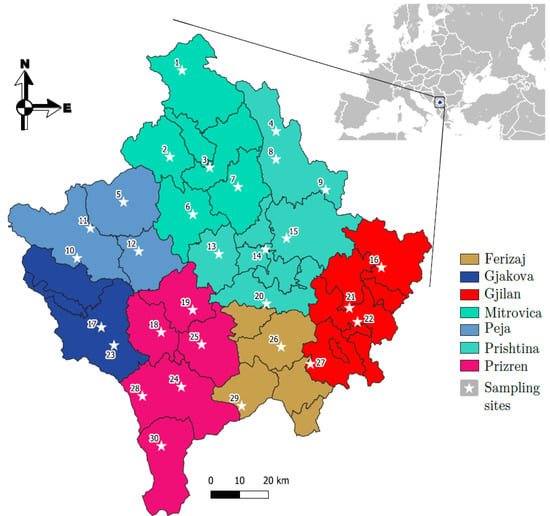
Figure 1.
The map of Kosovo and the location of the sampling points.
2.3. Experimental Methods
The radioactivity levels of the samples were analyzed using gamma spectrometry, which is an equipped, high-purity germanium gamma-ray detector ORTEC, with a 55% relative efficiency and a resolution of full width at half maximum (FWHM) of 1.90 keV at 1.33 MeV of peaks for the gamma of 60Co. The detector was shielded by a cylindrical lead shield, with an average thickness of 10 cm, to achieve a background level as low as possible. Efficiency and energy calibration of the detector was carried out with a 152Eu calibration source (Amersham Company, Amersham, UK). As standard procedure the cylindrical geometry of samples with constant volume and distance were applied to all samples.
2.4. Activity Concentration (A)
Each of the soil samples reaching the balance were placed on the detector and counted for a period of 60.000 s. The obtained gamma spectra were analyzed using data acquisition and analysis program named Gamma Vision []. The activity concentration of each sample was subtracted from the activity concentration of an empty plastic container to remove the contribution of the background radiation. To calculate the activity concentrations of the soil samples by specific radionuclide (A), we used Equation (1):
where C is the net count (area) under the corresponding peak, Ɛ is the detector efficiency at the corresponding peak energy, P is the absolute transition probability of the specific γ-ray at the corresponding peak energy, m is the mass of the sample (kg), and t is the counting time in seconds.
To measure the activity concentration of 226Ra, 232Th, 40K, and 137Cs on soil samples, we used standard methodology, based on γ-ray energies of specific elements. This procedure has been described elsewhere [,].
To calculate the uncertainty of the activity concentration (ΔA), we used Equation (2) [].
where ΔC is the uncertainty of count rate, ΔP is the uncertainty of emission probability found in the nuclear data tables, Δε is the uncertainty of efficiency, and Δm is the uncertainty of weighing.
To calculate the minimum detectable activity for each radionuclide, we used Equation (3) []:
where 1.645 is the statistical coverage factor (confidence level 95%), and B is the background for the related region of a specific radionuclide.
In addition, the accuracy of the measurements was obtained from the reference standard range of 95 to 98% for all radionuclides. The certified soil reference material (IAEA-375) checked the measurement system for accuracy with a matrix similar to the samples.
2.5. Calculation of Radiological Hazards
Radium equivalent activity (Raeq) is a widely used hazard index and was calculated through the relation given by Beretka and Mathew []. It was assumed that 370 Bq/kg of 226Ra, 259 Bq/kg of 232Th, and 4810 Bq/kg of 40K produced the same gamma-ray dose rate. The calculation is shown in Equation (4):
where ARa, ATh, and AK are the activity concentrations of related radionuclides, respectively.
Gamma index (Iγ)—Gamma index (Iγ) was calculated by using the Equation (5):
where ARa, ATh, and AK were explained in Equation (4) of this paper [].
External hazard indices (Hex) were calculated for the samples investigated using the model proposed by Krieger [], where the external hazard index is given by:
where ARa, ATh, and AK, were explained in Equation (4) of this paper
Absorbed dose rate in air (ADR) is the external terrestrial gamma radiation in the air at 1 m above ground level, due to the presence of 226Ra, 232Th, 40K, and 137Cs in the soil samples at each site. This was calculated using the following Equation (7) [],
where ARa, ATh, and AK, were explained in Equation (4) of this paper. The coefficients a, b, c, and d are the dose conversion factors, and their values are 0.462, 0.604, 0.042, and 0.1243 in nGy/h per Bq/kg, respectively.
The annual gonadal dose rate (AGDE)—The activity of bone marrow and bone surface cells are considered organs of interest by UNSCEAR []. Therefore, the AGDE, due to the activity concentrations of 226Ra, 232Th, and 40K, was calculated using Equation (8) []:
where ARa, ATh, and AK, were explained in Equation (4) of this paper. The coefficients 3.09, 4.18, and 0.314 are conversion factors in (Sv/y)/(Bq/kg).
The annual effective dose rate (AEDE)—The annual effective dose equivalent is given by using Equation (9):
where DCF is the dose conversion factor absorbed in the air (0.7 Sv/Gy), and OF is the outdoor occupancy factor (0.2) [].
Excess lifetime cancer risk (ELCR) is given by using Equation (10):
where DL is the life span (70 years) and RF is the risk factor (Sv−1), that is, mortal cancer risk per sievert. As stochastic effects, the ICRP 60 used values of 0.05 for the community [].
2.6. Spatial Interpolation and Mapping
The distribution maps created in this study were prepared according to the SGS-ANN approach suggested by Yeşilkanat []. In this approach, different from the original literature, each spatial pixel (100 × 100 m2) was calculated separately, using in a hybrid manner the conditional gauss simulation (SGS) and artificial neural network (ANN) methods in order to predict local changes rather than general distribution characteristics. Therefore, the population ratios and the radiological risks per pixel were calculated by weighting the population. More details about the ANN model can be found in the cited source [].
For all calculations and maps used in the study, SP [], GSTAT [], RSNNS [], and caret library files [] were used together with the R programming language [].
3. Results and Discussion
3.1. The Activity Concentrations of the Radionuclides
It was observed that the mean activity concentrations of these radionuclides were comparable with the worldwide average concentration []. In this context, all of the concentrations of 232Th and 226Ra were found to be below the world average. The average value of the 40K concentrations in the studied soil samples was lower than the world average. However, the 40K concentrations of site-1 (Leposaviq), site-2 (Zubin Potok), site-3 (Mitrovicë), site-4 (Podujevë), site-8 (Podujevë), site-10 (Pejë), site-15 (Prishtinë), site-17 (Gjakovë), and site-30 (Dragash) samples were slightly higher than the worldwide average. The difference in the activity values of the naturally occurring 40K in the soil samples had been fertilized with artificial fertilizers and contained residues from animal carcasses.
137Cs do not exist in soil naturally, but it is a product of fallout radioactivity. It might have been deposited in the soil of Kosovo, presumably due to the Chornobyl nuclear power accident on 26 April 1986, a nuclear weapon tests, or a reprocessing of spent nuclear fuel. The concentration of 137Cs in the trace level was reported on honey samples from Kosovo []. The study findings were compared to the values of some works used in other literature (Table 1). As shown in Table 1, the average activity value (22.32 Bq/kg) found for 226Ra in this study is lower than the reported values in Italy (79 Bq/kg) [], Saudi Arabia (23.2 Bq/kg) [], Lebanon (27 Bq/kg) [], Yemen (44.4 Bq/kg) [], Syria (29 Bq/kg) [], Artvin (42.2 Bq/kg) [], and Croatia (44.7 Bq/kg) [], while less results were reported for Bolu (18.2 Bq/kg) [], and Oman (14.4 Bq/kg) []. The average activity value (21.1 Bq/kg) found for 232Th is higher than the reported values in Saudi Arabia (7.7 Bq/kg), Oman (9.9 Bq/kg), and Turkey (17.3 Bq/kg), yet lower than the other values. The average activity value found for 40K is lower than the reported values in Italy (640 Bq/kg), Yemen (822.7 Bq/kg), and Croatia (542 Bq/kg) but higher than other values. In addition to these, the average activity value found for 137Cs in the soil samples is lower than the reported values in Italy (25 Bq/kg), Lebanon (21 Bq/kg), Oman (2770 Bq/kg), Syria (27 Bq/kg), and Croatia (30.8 Bq/kg) but higher than other values.

Table 1.
Comparisons of specific radionuclide concentrations by countries (Bq/kg).
The statistical summary information of the activity concentrations (actual data) obtained from the Kosovo soils’ experimental measurement results and the simulation distributions obtained by the SGS-ANN method for each radionuclide is shown in Table 2, comparatively. According to this, for the actual data, the activity concentrations of 226Ra, 232Th, 40K, and 137Cs varied from 8 Bq/kg to 30 Bq/kg, with a mean of 22 Bq/kg; 7 Bq/kg to 31 Bq/kg, with a mean of 21 Bq/kg; 105 Bq/kg to 515 Bq/kg, with a mean of 358 Bq/kg; and <MDA to 43 Bq/kg, with a mean of 13 Bq/kg, respectively. Similarly, for the simulation data, the activity concentrations of 226Ra, 232Th, 40K, and 137Cs varied from 12 Bq/kg to 29 Bq/kg, with a mean of 23 Bq/kg; 11 Bq/kg to 29 Bq/kg, with a mean of 21 Bq/kg; 181 Bq/kg to 541 Bq/kg, with a mean of 370 Bq/kg; and 1 to 41 Bq/kg, with a mean of 10 Bq/kg, respectively.

Table 2.
Statistics of the actual measurement and simulation of radionuclide activity concentrations in the soil of Kosovo.
In Table 2, statistics on the proportional changes of radionuclide activities are comparatively listed for both real data and simulation data. For the actual data, the 232Th/226Ra ratios varied from 0.69 to 1.21, with an average of 0.95 in Kosovo. The correlation between thorium and radium is lower than the world’s average (1.29). The 40K/226Ra ratios varied from 7.75 to 30.4, with an average of 16.5 in Kosovo. Its value is higher than the average of the world (11.77). Lastly, the 40K/232Th ratios varied from 7.13 to 29.9, with an average of 17.4 in Kosovo. The ratio value is greater than the world’s average (9.16). Similarly, for the simulation data, the 232Th/226Ra, 40K/226Ra, and 40K/232Th ratios varied from 0.68 to 1.33, with a mean of 0.93; 9.75 to 29.4, with a mean of 16.4; and from 9.83 to 27.6, with a mean of 17.6, respectively.
Correlations between natural radionuclide concentrations were also examined for real and simulation data. A significantly positive and strong correlation was determined between 232Th and 226Ra radionuclides (Figure 2). The variance explained (R2) between 232Th, and 226Ra radionuclides were calculated as 81% for actual data and 51% for simulation data. On the other hand, the correlations between 40K and 226Ra and 40K and 232Th were determined, and it was determined that there is a weak and positive relationship in both cases. The variance explained between 40K and 226Ra radionuclides were calculated as 14% for the actual data and 8.5% for the simulation data. Again, the variance explained between 40K and 232Th radionuclides were calculated as 10% for actual data and 7.3% for simulation data. The presence of a significant correlation between the activity concentrations of 226Ra, 232Th, and 40K radionuclides shows that radionuclides in soils of the study area are derived from the same natural source.
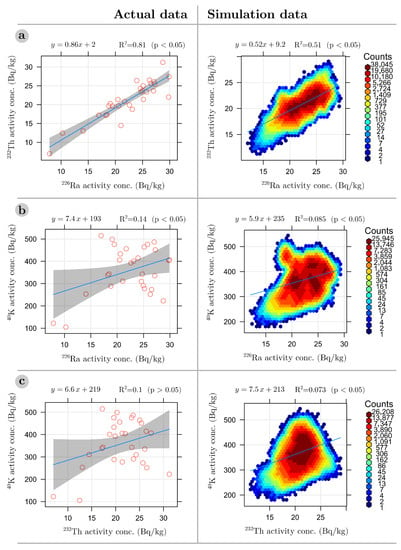
Figure 2.
Correlation analysis of natural radioisotopes (226Ra, 232Th, 40K) versus each other for actual and simulation data. (a) Correlation between 226Ra and 232Th activity concentration, (b) Correlation between 226Ra and 40K activity concentration, (c) Correlation between 232Th and 40K activity concentration.
Figure 3 comparatively shows the histograms of both actual and simulation data for the activity concentrations of 226Ra, 232Th, 40K, and 137Cs radionuclides. According to the Shapiro–Wilk normality test results, 232Th and 40K distributions were found to be normal (p > 0.05), while 226Ra and 137Cs distributions were log-normal (p > 0.05). In addition, it was determined that the distribution structures of the real measurement data and the simulation data were significantly similar (p > 0.05), according to the results of the two-sample Kolmogorov–Smirnov test. From all these findings, it could be seen that the simulation data, which reveal the radionuclide distribution for the entire study area, are very effective in representing real data.
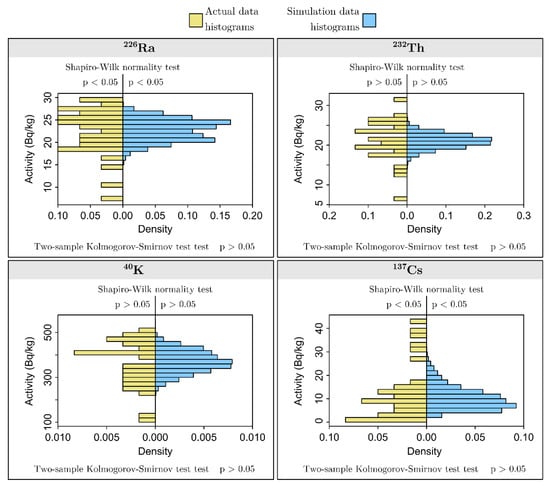
Figure 3.
Frequency distributions of 226Ra, 232Th, 40K, and 137Cs concentrations for actual and simulation data.
Figure 4 shows the performance metrics of the SGS-ANN estimation results. Explanations of these performance evaluation metrics are given in the Supplementary Material. According to the results of cross-validation, the Pearson correlation coefficients (significance, MAE in Bq/kg, RMSE in Bq/kg) for 226Ra, 232Th, 40K, and 137Cs were 0.34 (p < 0.05, 4.2, 5.0), 0.37 (p < 0.05, 3.9, 4.7), 0.42 (p < 0.05, 78.7, 95.6), and 0.40 (p < 0.05, 8.7, 11.4), respectively.
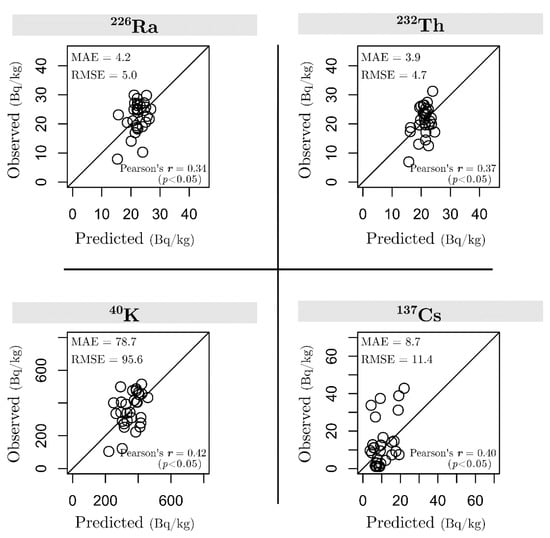
Figure 4.
The cross-validation diagrams generated as a result of comparing the predicted values with the observed values for 226Ra, 232Th, 40K, and 137Cs.
Figure 5 shows the distribution maps of the activity concentrations of 226Ra, 232Th, 40K, and 137Cs for Kosovo, generated by the SGS-ANN method at 100 × 100 m spatial pixel resolution. According to these distribution maps, it is noteworthy that natural radionuclide activities are higher in the northern, southern, and western parts of Kosovo compared to the inner and eastern parts. 137Cs artificial radionuclide activities are observed to be more effective in the eastern parts of the country close to Chernobyl.
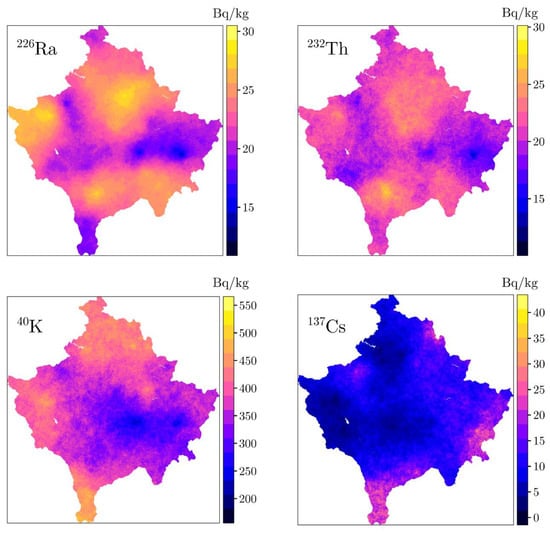
Figure 5.
Distributions of radioactivity concentration for 226Ra, 232Th, 40K, and 137Cs.
3.2. Assessment of Radiological Hazards
Statistical descriptors of Raeq, Iγ, and Hex radiological hazard indices were determined according to SGS-ANN simulation data for all Kosovo. The smallest and highest average Raeq, Iγ, and Hex values were determined in Gjilan (Raeq = 73 Bq/kg, Iγ = 0.55, Hex = 0.20) and Mitrovica (Raeq = 87 Bq/kg, Iγ = 0.66, Hex = 0.24), respectively.
In Kosovo soil samples, the mean value of Raeq was found to be 80.1 Bq/kg. This value is lower than the worldwide average of 370 Bq/kg []. Additionally, when the average Raeq values were compared with the values of other countries, they were found to be lower than the obtained values of 166 Bq/kg in Fırtına Valley [], 112 Bq/kg in Artvin [], and 232 Bq/kg in southwestern Nigeria []. The mean Iγ calculated for the Kosovo soil samples had a mean value of 0.61, which is less than the mean value of the world, which is 1, according to the European Commission (European Commission, 1999). The average value of Hex was found to be only 0.22, so no harmful effects to the residents can happen due to radiation hazards. Figure 6 shows distribution maps of radiological hazards for Kosovo. When these maps were examined, it was seen that radiological hazards are at low levels, especially in the province of Gjilan and in the inner parts of Prishtina. They are at high levels in the Mitrovica province, north of Prishtina, south of Prizren, and western parts of Gjakova and Peja.
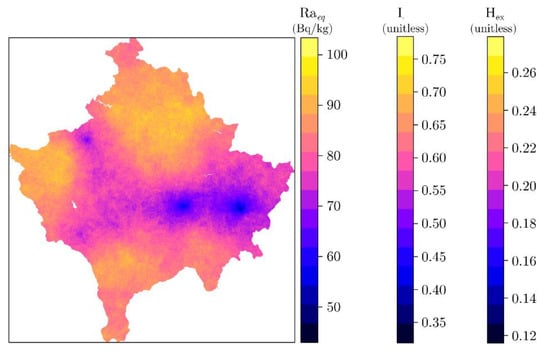
Figure 6.
The values of radiological hazard parameters, based on measured and simulated data from the soil.
3.3. Assessment of Radiological Health Risks
Statistical descriptors of AGDE, ADR, AEDE, and ELCR radiological health risk levels were determined according to SGS-ANN simulation data for all of Kosovo. The smallest and highest of the mean levels of AGDE, ADR, AEDE, and ELCR were determined in the provinces of Gjilan (AGDE = 248 µSv/year, ADR = 37 nGy/h, AEDE = 46 µSv/year and ELCR = 0.16 × 10−3) and Mitrovica (AGDE = 296 µSv/year, ADR = 43 nGy/h, AEDE = 53 µSv/year and ELCR = 0.18 × 10−3), respectively.
The mean AGDE value was found to be 269.8 µSv/year. These values are lower than the world mean (300 µSv/year) []. However, the maximum values calculated in all provinces except Gjilan were found to be higher than the global average. The mean of the absorbed dose rate (ADR) in the air, at 1 m above the ground, generated from gamma radiation of 226Ra, 232Th, 40K, and 137Cs in the soil samples of Kosovo resulted in 39.3 nGy/h, and this is 27% lower than the recommended values by UNSCEAR [].
In addition, the average AEDE of the soil samples that resulted was 48 μSv/y. It is lower than the average world value of 70 μSv/y []. The calculated values of the excess lifetime cancer risk (ELCR) for all soil samples ranged from 0.1 × 10−3 to 0.21 × 10−3, with a mean of 0.17 × 10−3. The average world value of ELCR is 0.29 × 10−3 []. The average ELCR acquired in this study was lower than the world’s mean values. Furthermore, the distribution map of these parameters calculated for Kosovo is shown in Figure 7 and Table 3.
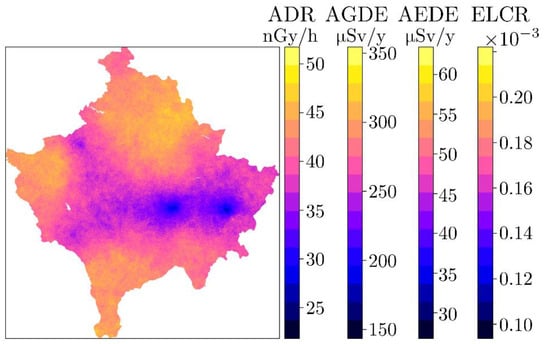
Figure 7.
Distributions of radiological health risks and calculated parameters ADR, AGDE, AEDE, and ELCR.

Table 3.
The values of radiologic hazard parameters calculated for the soil samples of Kosovo.
4. Conclusions
This study aimed to determine the levels of natural (226Ra, 232Th, and 40K) and artificial (137Cs) radioactivity of soil samples from Kosovo. It was done by using a high-purity germanium gamma-ray detector. The reported activity concentrations in the present study were within the proposed limits of international radiation protection agencies. In addition to activity measurements, the radiological hazard parameters: radium equivalent activity (Raeq), gamma index (Iγ), external hazard index (Hex), absorbed dose rate in the air (D), annual gonadal dose rate (AGDE), the annual effective dose rate (AEDE), and excess lifetime cancer risk (ELCR) were calculated, and the obtained results were lower than the world means for each mentioned parameter. Therefore, radioactivity concentration in the Kosovo soils is similar to the worldwide average and represents no radiological hazard for the population. The results obtained by this study will serve as a reference for possible future changes. Also, it provides a good baseline for the setting up of natural and artificial radioactivity mapping for monitoring possible radioactivity pollution.
Supplementary Materials
The following supporting information can be downloaded at: https://www.mdpi.com/article/10.3390/app12199520/s1, ref. [] is cited in the supplementary materials.
Author Contributions
Conceptualization, S.K., S.D. and G.H.; data curation, C.M.Y. formal analysis, C.M.Y.; investigation, S.D. and G.H.; methodology, S.D. and G.H.; project administration, S.K. and H.A.; resources, S.D. and S.K.; software, C.M.Y.; supervision, S.K.; validation, S.K. and G.H.; writing—original draft, S.D. and C.M.Y.; writing—review and editing, H.A. and G.H. All authors have read and agreed to the published version of the manuscript.
Funding
This research received no external funding.
Institutional Review Board Statement
Not applicable.
Informed Consent Statement
Not applicable.
Data Availability Statement
Not applicable.
Acknowledgments
The authors would like to thank the editor-in-chief, editor, and anonymous reviewers for their valuable reviews.
Conflicts of Interest
The authors declare no conflict of interest.
References
- Hodolli, G.; Kadiri, S.; Dumani, S.; Halimi, Y.; Jonuzaj, A.; Xhafa, B.; Hasani, F. Variation of total beta activity in air by years on Obiliq. J. Environ. Occup. Sci. 2012, 1, 121. [Google Scholar] [CrossRef]
- Turhan, Ş.; Köse, A.; Varinlioǧlu, A.; Şahin, N.K.; Arikan, T.I.; Oǧuz, F.; Yücel, B.; Özdemir, T. Distribution of terrestrial and anthropogenic radionuclides in Turkish surface soil samples. Geoderma 2012, 187–188, 117–124. [Google Scholar] [CrossRef]
- Danesi, P.R.; Markowicz, A.; Chinea-Cano, E.; Burkart, W.; Salbu, B.; Donohue, D.; Ruedenauer, F.; Hedberg, M.; Vogt, S.; Zahradnik, P.; et al. Depleted uranium particles in selected Kosovo samples. J. Environ. Radioact. 2003, 64, 143–154. [Google Scholar] [CrossRef]
- UNEP. Depleted Uranium in Kosovo, Post-Conflict Environmental Assessment (No. Scientific Team Mission to Kosovo 5–19 November 2000); UNEP: Geneva, Switzerland, 2001. [Google Scholar]
- Departamento de Protecção Radiológica e Segurança Nuclear. Report of the Portuguese Scientific Mission to Kosovo and to Bosnia- Herzegovina for Assessment of Radioactive Contamination and of the Radiological Risk Due to the Use of Depleted Uranium Ammunitions; Estrada Nacional 10, 2686–2953 Sacavém, Portugal, Relatório DPRSN-A, no 14 April 2001; MCT—Ministério da Ciência e Tecnologia: Lisbon, Portugal, 2001; Available online: http://www.ctn.tecnico.ulisboa.pt/uk/uk_reltec.htm (accessed on 13 September 2022).
- Carvalho, F.P.; Oliveira, J.M. Uranium isotopes in the Balkan’s environment and foods following the use of depleted uranium in the war. Environ. Int. 2010, 36, 352–360. [Google Scholar] [CrossRef]
- Zlobina, A.; Farkhutdinov, I.; Carvalho, F.P.; Wang, N.; Korotchenko, T.; Baranovskaya, N.; Farkhutdinov, A. Impact of Environmental Radiation on the Incidence of Cancer and Birth Defects in Regions with High Natural Radioactivity. Int. J. Environ. Res. Public Health 2022, 19, 8643. [Google Scholar] [CrossRef]
- Alzubaidi, G.; Hamid, F.B.S.; Abdul Rahman, I. Assessment of Natural Radioactivity Levels and Radiation Hazards in Agricultural and Virgin Soil in the State of Kedah, North of Malaysia. Sci. World J. 2016, 2016, 6178103. [Google Scholar] [CrossRef]
- Amanjeet; Kumar, A.; Kumar, S.; Singh, J.; Singh, P.; Bajwa, B.S. Assessment of natural radioactivity levels and associated dose rates in soil samples from historical city Panipat, India. J. Radiat. Res. Appl. Sci. 2017, 10, 283–288. [Google Scholar] [CrossRef]
- Shohda, A.M.; Draz, W.M.; Ali, F.A.; Yassien, M.A. Natural radioactivity levels and evaluation of radiological hazards in some Egyptian ornamental stones. J. Radiat. Res. Appl. Sci. 2018, 11, 323–327. [Google Scholar] [CrossRef]
- Tabar, E.; Yakut, H.; Saç, M.M.; Taşköprü, C.; İçhedef, M.; Kuş, A. Natural radioactivity levels and related risk assessment in soil samples from Sakarya, Turkey. J. Radioanal. Nucl. Chem. 2017, 313, 249–259. [Google Scholar] [CrossRef]
- Taşkın, H.; Yeşilkanat, C.M.; Kobya, Y.; Çevik, U. Evaluation And Mapping Of Radionuclides in The Terrestrial Environment And Health Hazard Due To Soil Radioactivity in Artvin, Turkey. Arab. J. Geosci. 2018, 11, 729. [Google Scholar] [CrossRef]
- Yeşilkanat, C.M.; Kobya, Y.; Taşkin, H.; Çevik, U. Dose rate estimates and spatial interpolation maps of outdoor gamma dose rate with geostatistical methods; A case study from Artvin, Turkey. J. Environ. Radioact. 2015, 150, 132–144. [Google Scholar] [CrossRef] [PubMed]
- Kobya, Y.; Taşkın, H.; Yeşilkanat, C.M.; Çevik, U. Evaluation of Outdoor Gamma Dose Rate and Cancer Risk in Artvin Province, Turkey. Hum. Ecol. Risk Assess. 2015, 21, 2077–2085. [Google Scholar] [CrossRef]
- Ugbede, F.O.; Osahon, O.D. Soil-to-plant transfer factors of 238U and 232Th in rice from Ezillo paddy fields, Ebonyi State, Nigeria. J. Environ. Radioact. 2021, 233, 106606. [Google Scholar] [CrossRef] [PubMed]
- Raj, P.; Padiyath, N.; Semioshkina, N.; Addad, Y.; Foulon, F.; Francis, D.; Voigt, G. Conceptualization of arid region radioecology strategies for agricultural ecosystems of the United Arab Emirates (UAE). Sci. Total Environ. 2022, 832, 154965. [Google Scholar] [CrossRef] [PubMed]
- Uosif, M.A.M.; Alrowaili, Z.A.; Elsaman, R.; Mostafa, A.M.A. Soil–soybean transfer factor of natural radionuclides in different soil textures and the assessment of committed effective dose. Radiat. Prot. Dosim. 2020, 188, 529–535. Available online: https://academic.oup.com/rpd/article/188/4/529/5735230 (accessed on 13 September 2022). [CrossRef] [PubMed]
- IAEA. Technical Report Series; Guidelines on Soil and Vegetation Sampling for Radiological Monitoring; IAEA Division of Public Information, No. 486; IAEA: Vienna, Austria, 2019. [Google Scholar]
- GammaVision Gamma Spectroscopy. Application Software | AMETEK ORTEC. Available online: https://www.ortec-online.com/products/application-software/gammavision (accessed on 13 September 2022).
- IAEA. Radiation Safety; IAEA Division of Public Information, 96-00725 IAEA; IAEA: Vienna, Austria, 1996. [Google Scholar]
- ICRP. 1990 Recommendations of the International Commission on Radiological Protection. In ICRP Publication 60. Ann. ICRP; Pergamon Press: Oxford, UK, 1991. [Google Scholar]
- Khandaker, M.U.; Jojo, P.J.; Kassim, H.A.; Amin, Y.M. Radiometric analysis of construction materials using HPGe gamma-ray spectrometry. Radiat. Prot. Dosim. 2012, 152, 33–37. [Google Scholar] [CrossRef]
- Currie, L.A. Limits for Qualitative Detection and Quantitative Determination: Application to Radiochemistry. Anal. Chem. 1968, 40, 586–593. [Google Scholar] [CrossRef]
- Beretka, J.; Mathew, P.J. Natural Radioactivity of Australian Building Materials. Ind. Wastes By-Products. Health Phys. 1985, 48, 87–95. [Google Scholar]
- European Commission. Radiation Protection 112: Radiological Protection Principles Concerning the Natural Radioactivity of Building Materials; European Commission: Brussels, Belgium, 1999; pp. 1–16.
- Krieger, R. Radioactivity of Construction Materials. Betonw. Fert. Technol. 1981, 47, 468–473. [Google Scholar]
- UNSCEAR. Sources and Effects of Ionizing Radiation; United Nations Scientific Committee on the Effects of Atomic Radiation; United Nations Publication: New York, NY, USA, 2008. [Google Scholar]
- UNSCEAR. Source and Effects of Ionizing Radiation; United Nations Scientific Committee on the Effects of Atomic Radiation, Report to the General Assembly with Annex B; United Nations Publication: New York, NY, USA, 2000. [Google Scholar]
- Mamont-Ciesla, K.; Gwiazdowski, B.; Biernacka, M.; Zak, A. Radioactivity of Building Materials in Poland. 1982. Available online: https://inis.iaea.org/search/search.aspx?orig_q=RN:16033994 (accessed on 13 September 2022).
- ICRP. Recommendations of the ICRP: Annals of the ICRP (International Commission on Radiological Protection); Publication 103 Volume 37/2-4; ICRP: Ottawa, ON, Canada, 2007. [Google Scholar]
- Yeşilkanat, C.M. A novel hybrid approach to the mapping and prediction of the terrestrial gamma dose rate distribution in the Central Anatolia Region of Turkey. J. Environ. Radioact. 2019, 208–2009, 106009. [Google Scholar] [CrossRef]
- Pebesma, E.J.; Bivand, R. Classes and methods for spatial data in R. R News 2005, 4, 9–13. [Google Scholar]
- Pebesma, E.J.; Wesseling, C.G. Gstat: A program for geostatistical modelling, prediction and simulation. Comput. Geosci. 1998, 24, 17–31. [Google Scholar] [CrossRef]
- Bergmeir, C.; Benítez, J.M. Neural Networks in R Using the Stuttgart Neural Network Simulator: RSNNS. J. Stat. Softw. 2012, 46, 1–26. [Google Scholar] [CrossRef]
- Kuhn, M.; Wing, J.; Weston, S.; Williams, A.; Keefer, C.; Engelhardt, A.; Cooper, T.; Mayer, Z.; Kenkel, B.; Benesty, M.; et al. caret: Classification and Regression Training. R Packag. Version 6.0-86. 2020. Available online: https://cran.r-project.org/web/packages/caret/index.html (accessed on 13 September 2022).
- Ihaka, R.; Gentleman, R. R: A Language for Data Analysis and Graphics. J. Comput. Graph. Stat. 1996, 5, 299–314. [Google Scholar] [CrossRef]
- Dizman, S.; Hodolli, G.; Kadiri, S.; Aliu, H.; Makolli, S. Radioactivity in Kosovo honey samples. Pol. J. Environ. Stud. 2020, 29, 1119–1127. [Google Scholar] [CrossRef]
- Guidotti, L.; Carini, F.; Rossi, R.; Gatti, M.; Cenci, R.M.; Beone, G.M. Gamma-spectrometric measurement of radioactivity in agricultural soils of the Lombardia region, northern Italy. J. Environ. Radioact. 2015, 142, 36–44. [Google Scholar] [CrossRef] [PubMed]
- Alshahri, F.; El-Taher, A. Investigation of natural radioactivity levels and evaluation of radiation Hazards in residential-area soil near a Ras Tanura refinery, Saudi Arbia. Pol. J. Environ. Stud. 2019, 28, 25–34. [Google Scholar] [CrossRef]
- El Samad, O.; Baydoun, R.; Nsouli, B.; Darwish, T. Determination of natural and artificial radioactivity in soil at North Lebanon province. J. Environ. Radioact. 2013, 125, 36–39. [Google Scholar] [CrossRef]
- Abd El-mageed, A.I.; El-Kamel, A.H.; Abbady, A.; Harb, S.; Youssef, A.M.M.; Saleh, I.I. Assessment of natural and anthropogenic radioactivity levels in rocks and soils in the environments of Juban town in Yemen. Radiat. Phys. Chem. 2011, 80, 710–715. [Google Scholar] [CrossRef]
- Al-Masri, M.S.; Amin, Y.; Hassan, M.; Ibrahim, S.; Khalili, H.S. External gamma-radiation dose to Syrian population based on the measurement of gamma-emitters in soils. J. Radioanal. Nucl. Chem. 2006, 267, 337–343. [Google Scholar] [CrossRef]
- Ivanić, M.; Fiket, Ž.; Medunić, G.; Furdek Turk, M.; Marović, G.; Senčar, J.; Kniewald, G. Multi-element composition of soil, mosses and mushrooms and assessment of natural and artificial radioactivity of a pristine temperate rainforest system (Slavonia, Croatia). Chemosphere 2019, 215, 668–677. [Google Scholar] [CrossRef] [PubMed]
- Dizman, S.; Görür, F.K.; Keser, R.; Görür, O. The assessment of radioactivity and radiological hazards in soils of Bolu province, Turkey. Environ. Forensics 2019, 20, 211–218. [Google Scholar] [CrossRef]
- Saleh, I.H. Radioactivity of 238U, 232Th, 40K, and 137Cs and assessment of depleted uranium in soil of the Musandam Peninsula, Sultanate of Oman. Turk. J. Eng. Environ. Sci. 2012, 36, 236–248. [Google Scholar] [CrossRef]
- Mostafa, A.M.A.; Uosif, M.A.M.; Elsaman, R.; Alrowaili, Z.A.; Moustafa, E. The dependence of natural radioactivity levels and its radiological hazards on the texture of agricultural soil in Upper Egypt. Environ. Earth Sci. 2020, 79, 228. [Google Scholar] [CrossRef]
- Kurnaz, A.; Küçükömeroǧlu, B.; Keser, R.; Okumusoglu, N.T.; Korkmaz, F.; Karahan, G.; Çevik, U. Determination of radioactivity levels and hazards of soil and sediment samples in Firtina Valley (Rize, Turkey). Appl. Radiat. Isot. 2007, 65, 1281–1289. [Google Scholar] [CrossRef]
- Jibiri, N.N.; Isinkaye, M.O.; Bello, I.A.; Olaniyi, P.G. Dose assessments from the measured radioactivity in soil, rock, clay, sediment and food crop samples of an elevated radiation area in south-western Nigeria. Environ. Earth Sci. 2016, 75, 107. [Google Scholar] [CrossRef]
- Ademola, J.A. Determination of natural radionuclides content in some building materials in nigeria by gamma-ray spectrometry. Health Phys. 2008, 94, 43–48. [Google Scholar] [CrossRef]
- Draper, N.R.; Smith, H. Applied Regression Analysis; Wiley: New York, NY, USA, 1998. [Google Scholar]
Publisher’s Note: MDPI stays neutral with regard to jurisdictional claims in published maps and institutional affiliations. |
© 2022 by the authors. Licensee MDPI, Basel, Switzerland. This article is an open access article distributed under the terms and conditions of the Creative Commons Attribution (CC BY) license (https://creativecommons.org/licenses/by/4.0/).